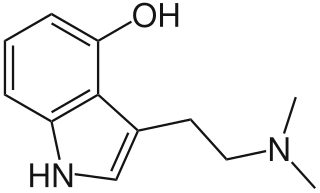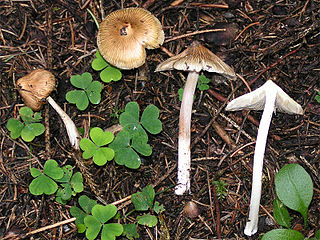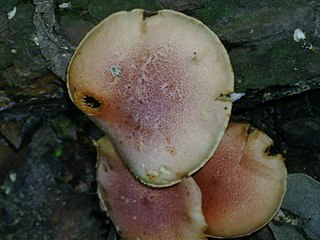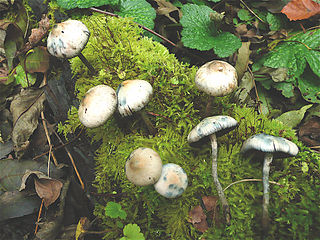
Psilocybin mushrooms, commonly known as magic mushrooms or shrooms, are a polyphyletic informal group of fungi that contain psilocybin, which turns into psilocin upon ingestion. Biological genera containing psilocybin mushrooms include Psilocybe, Panaeolus, Inocybe, Pluteus, Gymnopilus, and Pholiotina.

Psilocybe is a genus of gilled mushrooms, growing worldwide, in the family Hymenogastraceae. Most or nearly all species contain the psychedelic compounds psilocybin and psilocin.

Psilocin is a substituted tryptamine alkaloid and a serotonergic psychedelic substance. It is present in most psychedelic mushrooms together with its phosphorylated counterpart psilocybin. Psilocin is a Schedule I drug under the Convention on Psychotropic Substances. Acting on the 5-HT2A receptors, psilocin modulates the production and reuptake of serotonin. The mind-altering effects of psilocin are highly variable and subjective and resemble those of LSD and DMT.

Baeocystin is a zwitterionic alkaloid and analog of psilocybin. It is found as a minor compound in most psilocybin mushrooms together with psilocybin, norbaeocystin, aeruginascin, and psilocin. Baeocystin is an N-demethylated derivative of psilocybin, and a phosphorylated derivative of 4-HO-NMT (4-hydroxy-N-methyltryptamine). The structures at right illustrate baeocystin in its zwitterionic form.

Norbaeocystin is a psilocybin mushroom alkaloid and analog of psilocybin. It is found as a minor compound in most psilocybin mushrooms together with psilocin, psilocybin, aeruginascin, and baeocystin, from which it is a derivative.

Inocybe is a large genus of mushroom-forming fungi with over 1400 species, including all forms and variations. Members of Inocybe are mycorrhizal, and some evidence shows that the high degree of speciation in the genus is due to adaptation to different trees and perhaps even local environments.

Gymnopilus junonius is a type of mushroom-forming fungus in the family Hymenogastraceae. Commonly known as the spectacular rustgill, this large orange mushroom is typically found growing on tree stumps, logs, or tree bases. Some subspecies of this mushroom contain the neurotoxic oligoisoprenoid gymnopilin.

Gymnopilus is a genus of gilled mushrooms within the fungal family Hymenogastraceae containing over 200 rusty-orange spored mushroom species formerly divided among Pholiota and the defunct genus Flammula. The fruit body is typically reddish brown to rusty orange to yellow, medium to large, often with a well-developed veil. Most members of Gymnopilus grow on wood but at times may appear terrestrial if the wood is buried or decomposed. Members of Pholiota and Cortinarius are easy to confuse with Gymnopilus. Pholiota can be distinguished by its viscid cap and duller spores, and Cortinarius grows on the ground. Beginners can confuse Gymnopilus with Galerina, which contains deadly poisonous species.

Conocybe is a genus of mushrooms with Conocybe tenera as the type species and at least 243 other species. There are at least 50 different species in North America.

Pholiotina cyanopus is a species of fungus that contains psychoactive compounds including psilocybin and the uncommon aeruginascin. Originally described as Galerula cyanopus by American mycologist George Francis Atkinson in 1918. It was transferred to Conocybe by Robert Kühner in 1935 before being transferred to Pholiotina by Rolf Singer in 1950. A 2013 molecular phylogenetics study found it to belong to a group of species currently assigned to Pholiotina that are more closely related to Galerella nigeriensis than to Pholiotina or Conocybe. It is likely that it will be moved to a different genus in the future, but this has not happened yet.

Gymnopilus luteofolius, known as the yellow-gilled gymnopilus, is a large and widely distributed mushroom that grows in dense clusters on dead hardwoods and conifers. It grows in late July to November in the east and in the winter on the west coast of North America. It has a rusty orange spore print and a bitter taste.

Gymnopilus aeruginosus, also known as the magic blue gym, is a mushroom-forming fungus that grows in clusters on dead wood and wood chip mulch. It is widely distributed and common in the Pacific Northwest. It has a rusty orange spore print and a bitter taste and contains the psychedelic chemical psilocybin. It was given its current name by mycologist Rolf Singer in 1951.

Gymnopilus sapineus, commonly known as the scaly rustgill or common and boring gymnopilus, is a small and widely distributed mushroom which grows in dense clusters on dead conifer wood. It has a rusty orange spore print and a bitter taste. This species does not stain blue and lacks the hallucinogen psilocybin.

Aeruginascin or N,N,N-trimethyl-4-phosphoryloxytryptamine is an indoleamine derivative which occurs naturally within the mushrooms Inocybe aeruginascens and Pholiotina cyanopus, and Psilocybe cubensis. Aeruginascin is the N-trimethyl analogue of psilocybin. It is closely related to the frog skin toxin bufotenidine (5-HTQ), a potent 5-HT3 receptor agonist, but the aeruginascin metabolite 4-HO-TMT shows strong binding at the 5-HT2 receptors similar to psilocin. The first scientific literature about the pharmacological effects of aeruginascin is from a study published by Gartz in 1989. Across 23 analyzed cases of accidental hallucinogenic mushroom poisonings, people who had ingested the mushroom Inocybe aeruginascens reported only euphoric experiences. This is in contrast to the slight and in some cases extremely dysphoric experiences reported from the accidental ingestion of non aeruginascin containing mushrooms (containing solely psilocybin and psilocin).

Gymnopilus subpurpuratus is a species of mushroom in the family Hymenogastraceae. The type specimen was found in Jalisco, Mexico, growing on rotting pine wood in a garden. The fungus was described as new to science in 1991 by Gastón Guzmán and his daughter Laura Guzmán Dávalos.
Gymnopilus suberis is a species of mushroom in the family Hymenogastraceae. It was given its current name by mycologist Rolf Singer in 1951.
Gymnopilus nevadensis is a species of mushroom in the family Hymenogastraceae. The fungus was described as new to science in 1991 by Gastón Guzmán and his daughter Laura Guzmán Dávalos. The type collection was found in Jalisco, Mexico, where it was fruiting in a cluster on a dead branch in a pine and oak woodland.

Psilocybe serbica is a species of mushroom in the family Hymenogastraceae. The mushroom contains the psychotropic compounds psilocybin and psilocin, and also related tryptamine alkaloids baeocystin, norbaeocystin, and aeruginascin. It is closely related to Psilocybe aztecorum. It was reported as new to science by Meinhard Moser and Egon Horak in 1969. Molecular analysis published in 2010 has shown that P. serbica is the same species as Psilocybe bohemica described by Šebek in 1983, Psilocybe arcana described by Borovička and Hlaváček in 2001, and Psilocybe moravica by Borovička in 2003. Psilocybe serbica is common in Central Europe.

Inosperma calamistratum, until 2019 known as Inocybe calamistrata, is an inedible species of Inocybaceae fungus found in Europe and North America. Orson K. Miller Jr. and Hope Miller list it as poisonous. It used to be suspected of being psychotropic because of the blue-green tinge present at the stipe base, but psilocybin and similar alkaloids have not been found in the fruiting bodies.
















